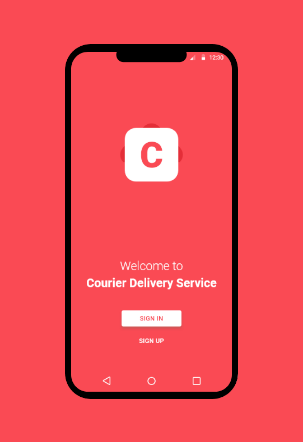Many logistic companies strive to enhance their business operations by achieving better delivery capacity and cost savings.
By utilizing advanced tracking systems and implementing efficient transportation rules, logistic businesses can improve customer satisfaction and increase profits. This is where custom load planning software development comes into play, allowing companies and businesses to streamline their shipping process overall.
Moreover, investors and entrepreneurs who don’t have logistics businesses can still enter this market by targeting other logistics businesses with software development.
The growing market of load planning software indicates a better opportunity for individuals and entrepreneurs seeking to tap into profitable markets with application development.
In this article, we will delve into must-have features, development steps, and other important aspects that can help you start load planning software development.
What Is Load Planning Software?
A computer application designed to optimize the arrangement of packages, cargo items within transportation vehicles such as trailers, containers, trucks, plans, etc.
The primary purpose of load planning software is to efficiently utilize available space in vehicles, in addition to ensuring that weight distribution is balanced and cargo is secured properly.
The load planning software uses optimization techniques and algorithms for creating an optimized load plan that enables owners to maximize the use of available space, reducing empty spaces and preventing the risk of damaged goods during transit.
How Does Load Planning Software Work?
The software utilizes various optimization techniques and algorithms to enable the efficient arrangement of cargo or items within transportation vehicles. Here is the overview of the working of load planning software.
1. Input Data
The users submit relevant information into the software, including details of the goods that need to be in transit, such as dimensions, weight, and special handling requirements, and the characteristics of transportation vehicles, such as size, capacity, and weight limits, etc.
2. Vehicle and Load Representation
The load planning software creates virtual representations of items needed to be loaded and transportation vehicles. The virtual representation can take the form of a 2D layout or 3D model, depending on the complexity of the software.
3. Constraints and Safety Considerations
Various safety considerations need to be considered, such as weight limit, center of gravity restrictions, and any specific rules related to hazardous material or fragile items.
4. Optimization Process
There is the use of various algorithms for optimizing different important aspects of transportation, such as maximizing space utilization, maintaining stability during transportation, minimizing empty spaces, etc.
The software utilizes various combinations and permutations of different items to find the most efficient loading plan.
5. Load Plan Visualization
After properly optimizing the transportation process, the software presents a graphical visualization of the loading plan, allowing users to inspect the arrangement of items in the vehicles carefully.
6. Load Validation and Safety Checks
The software performs various safety checks to ensure the weight limits are in accordance with safety regulations. The software also verifies that cargo is placed properly to prevent any possible damage to the goods during transit.
7. Real-Time Tracking (optional)
Load planning software also provides integration with a real-time tracking system for enabling vehicle owners to monitor the cargo status during transportation. Moreover, this feature lets users stay informed about the condition and the location of the real-time shipment.
8. Reporting and Documentation
The software generates reports detailing loaded items such as safety-related information, weight distribution, etc. Moreover, this information can be shared with stakeholders for documentation purposes enabling transportation companies to optimize their operations, increasing efficiency and reducing cost.
Types Of Load Planning Software
The load planning software typically falls under two main categories, i.e., FCL/FTL shipping and LCL/LTL shipping. Understanding both of them will help you select the appropriate one for your software development.
1. FCL/FTL Shipping
FCL/FTL shipping is a full container load/full truck loading shipping where shipments are directly loaded onto the career by shippers or manufacturers. This kind of software provides full control to the shipper over the contents of the container and turns out to be more cost-effective for large shipments.
Moreover, FCL/FTL shipping offers direct transportation without requiring intermediate stops and transfers, which can reduce transit times and handling risks.
2. LCL/LTL Shipping
TCL/LTL shipping stands for Less than Container Load/ Less than Truck Loading Shipping, where the optimal shipping cost is one of the major benefits here. In this shipping model, third-party logistic partner plays a major role and are responsible for arranging the products instead of the manufacturers.
The LTL model is ideal for shippers that do not require a full truck capacity and are more cost-effective for smaller shippers and businesses with lower shipping volume requirements.
Why Business Needs Load Planning Software?
Businesses involved in logistics and supply chain transportation can utilize load planning software to improve their efficiency and optimize business operations. Here are a few reasons why businesses need load planning software:
1. Efficient Resource Utilization
The software enables businesses to optimize the use of available resources, such as containers, trucks, and warehouses, in the most efficient way. Companies can reduce empty space and minimize wasted capacity by efficiently allocating these resources, which leads to cost savings and increased productivity.
2. Improved Customer Service
With efficiently timely deliveries and reduced chances of delays, companies can improve customer satisfaction with accurate load planning. This can result in providing more reliable delivery estimates and consistently meeting customer expectations.
3. Compliance and Safety
Logistics and other businesses can utilize load planning software to comply with regulatory requirements such as weight limits, axle loads, and essential regulatory requirements. Businesses complying with transportation regulations can help themselves avoid penalties, fines, or any potential accidents.
4. Cost Reduction
Businesses can reduce transportation costs by ensuring the full utilization of containers, properly optimizing routes, and reducing the number of trips required. Moreover, the companies can also explore the most cost-effective shipping options and careers with the help of load planning software.
5. Scalability and Flexibility
Load planning software enables businesses to grow and adjust plans efficiently and quickly in accordance with changing shipping volumes. Having the flexibility to change plans accordingly results in evolving customer needs plus greater scalability and flexibility in terms of load shipping.
Must-Have Features For Load Planning Software
A load planning software offers a set of features that enables vehicle owners to optimize the load planning process for goods and items. Here are some of the most have features that must be on load planning software.
1. Container Capacity
A must-have feature that enables vehicle owners to quickly determine the maximum weight and volume of cargo that can fit inside each container or trailer, thus maximizing the transport capacity.
Moreover, planning numerous cargoes simultaneously help transportation companies to maximize the available shipping resources.
2. Sequence Picking
The feature enables vehicle owners to carefully determine the best way to load items and goods, in addition to cutting down the number of trips and preventing any possible damage while loading.
The feature is helpful for maximizing efficiency and reducing the effort and time needed to finish the loading process as it optimizes a sequence in which the vehicle owner has to pick and load the goods and items.
3. Constraints Support
A careful shipping restriction must be included in load planning applications which can be done by integrating constraints support into the software. The feature will assist transportation companies in creating loads that are in accordance with operational and regulatory limitations such as load weight restriction, size restrictions, etc.
4. 3D Visualization
Another useful feature that transportation companies can utilize for visualizing the loads in a detailed and realistic manner using the 3D visualization technique, giving them a clear idea about how cargo will fit inside the container or caravan.
The feature identifies any spots and gaps and makes necessary adjustments for stabilizing the load to keep them secure throughout travel.
5. Trailer Management
The feature allows vehicle owners to control and track the trailers or containers that are used to carry merchandise.
Trailer management is a simple tool that keeps tabs on the availability of containers or trailers, in addition to tracing their whereabouts and confirming that they are in excellent condition. The feature is often beneficial for reducing time and expenses as it optimizes the shipping routes using efficient algorithms.
6. Balance Management
A crucial feature for minimizing the possibility of goods while in transit, as it enables transport owners to quickly change their load plan for distributing goods safely and stably during transportation.
Steps To Develop Load Planning Software
The development process of load planning software involves a series of steps that ensures its successful development and deployment. Here are the key steps to get started.
1. Establish a Strategy For Your Logistics Business
It is crucial for you to define your project requirements and business goals want to achieve, such as increasing payload capacity or wanting an automated solution to minimize overhead due to load planning optimization.
Defining your business requirement will help software developers to create detailed project specifications and select the right technical stack and software features fitting your unique business needs.
2. Set Up Load Optimization Algorithms
Load optimization algorithm can be established by knowing your business needs and requirements. You can consider various aspects of your logistics business, such as whether freight should be located on the floor or freight should be placed in a defined ratio. What is the certain standard freight should have when located in unit loads?
There are many other important criteria you can consider when setting up a load optimization algorithm for your software.
3. Select Your Software Development Partner
Selecting an appropriate app development company is crucial to simplify your software development process and get maximum returns on your investment. Here are a few criteria to help you select the best software development company.
I. Industry Experience
It is crucial for a software development company to have a relevant experience in software development for the logistics and transportation industry.
You can consider checking the portfolio of software they have developed for their past clients, especially those coming from the logistics and transportation industry.
II. Communication Process
Several crucial aspects of engagement and communication, such as language barrier, communication skills other important criteria, can impact the communication process among your team and software development company. Therefore, it becomes essential for you to select an app development company that can communicate in English and have a flexible communication process.
III. Client Feedback
Figuring out the software delivery experience of past clients of specific app development companies is another way to find out their suitability with your load planning software development project.
There are various professional platforms, such as Clutch, GoodFirms, etc., where you can see real customer feedback from many software development companies.
Here is a complete guide about how to hire app developers in 2023.
4. Design and Architecture
The next step is to start user interface design for your software. The software developers will create a user interface enabling users to access your application and its features. Practicing modern design patterns is the best way to ensure the scalability and maintainability of your application in terms of user interface design.
5. Develop MVP Of Load Planning Software
MVP stands for Minimum Viable Product, which includes basic features to make your load planning software fully functional. Later based on your business needs, you can optimize and improve your software by developing more features and functionality and integrating any required third-party APIs.
6. Test & Deploy Your Software
After developing the MVP of your software, the developers will perform software testing to eliminate any technical glitches. Also, you can prepare a deployment strategy for your load planning software on servers and cloud infrastructure to distribute them among your app users.
The software development company will create an effective deployment strategy for ensuring the maximum scalability of your load-planning software.
Top 5 Load Planning Software
There are numerous load planning software available in the market that are worth checking out. Exploring the following software can help you with getting an idea about their business strategy.
1. SeaRates Tools
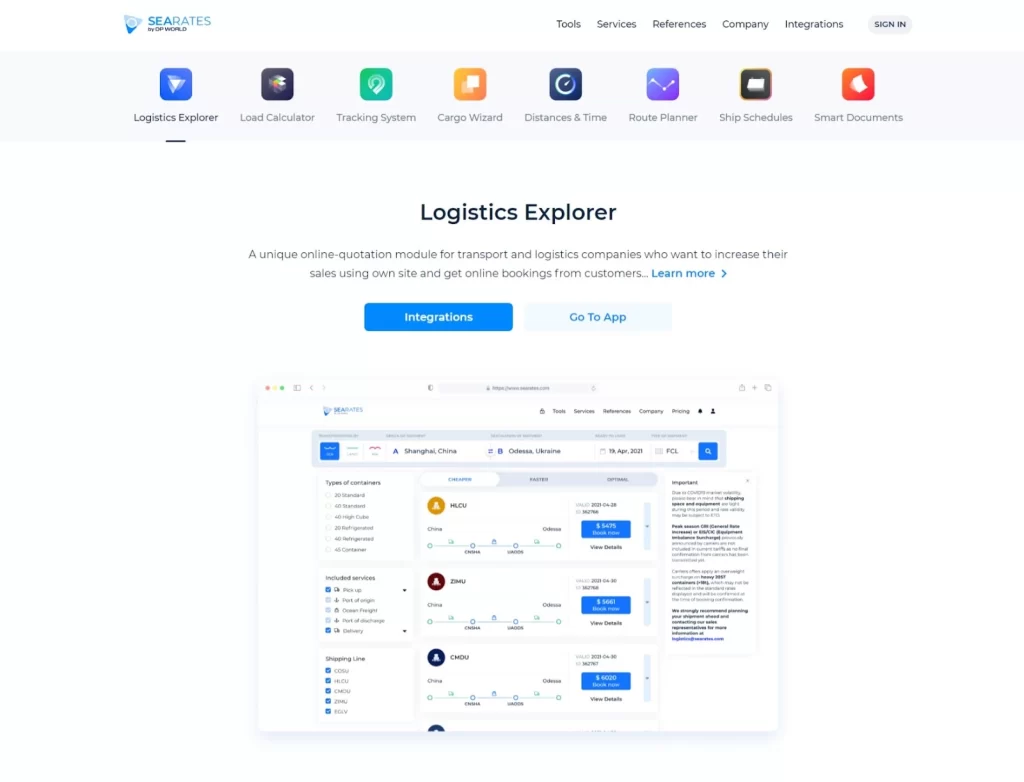
One of the largest tariff search engines for international shipping that offers services related to cargo insurance and online payments. Moreover, the platform compares all available delivery cargo options and arranges insurance and transportation for their customers.
SeaRate tools provide overall control and transparency by facilitating the fastest transit time with the lowest price for both FCL and LCL kinds of shipping.
- Founded in: 2005
- Developed by: DP World
- Headquarters: Dubai, UAE
- Starting price: $399.00/one-time
2. Cargo Wiz
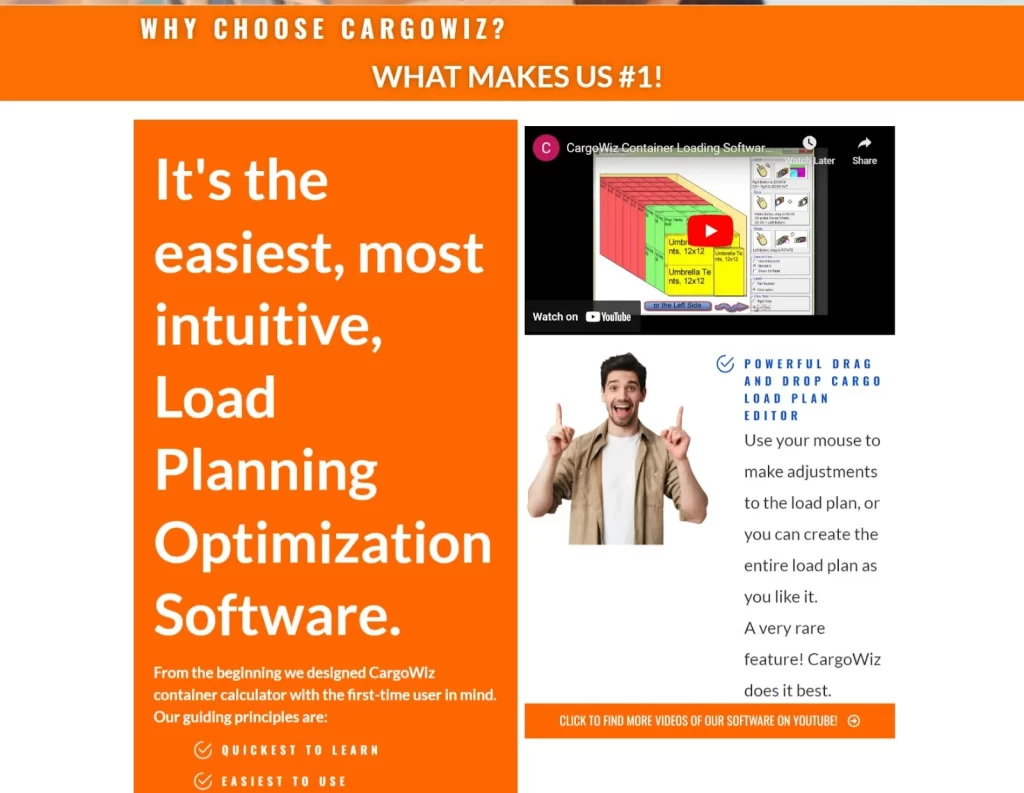
The platform provides a calculator for adjusting the load plan or creating an entire one starting from scratch.
In the case of partially filled containers, the CargoWiz provides solutions for rearranging the loads to utilize more of the floorspace, overall improving weight distribution and stability.
- Founded in: 1998
- Developed by: Softtruck
- Headquarters: US
- Starting price: $747 one-time payment
3. Load!
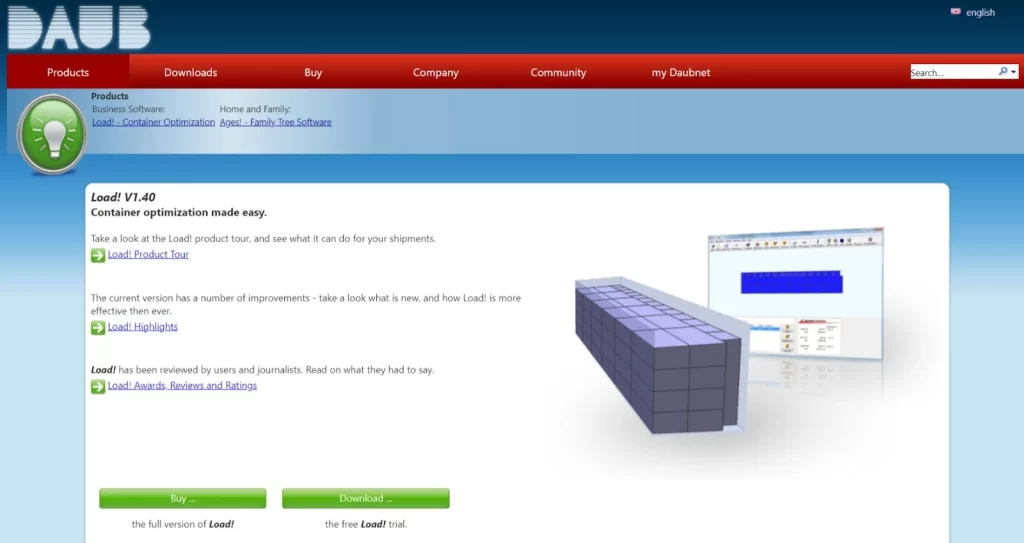
One of the best load optimizing platforms that optimizes the different aspects of shipment such as packing list, freight cost, and calculating a maximum number of packages per container type.
The platform also offers 3D viewing of load optimization enabling logistic owners to optimize their shipping operations better.
- Founded in: 2012
- Developed by: Daub
- Headquarters: UK
- Starting price: $79 one-time payment
4. Cargo Planner
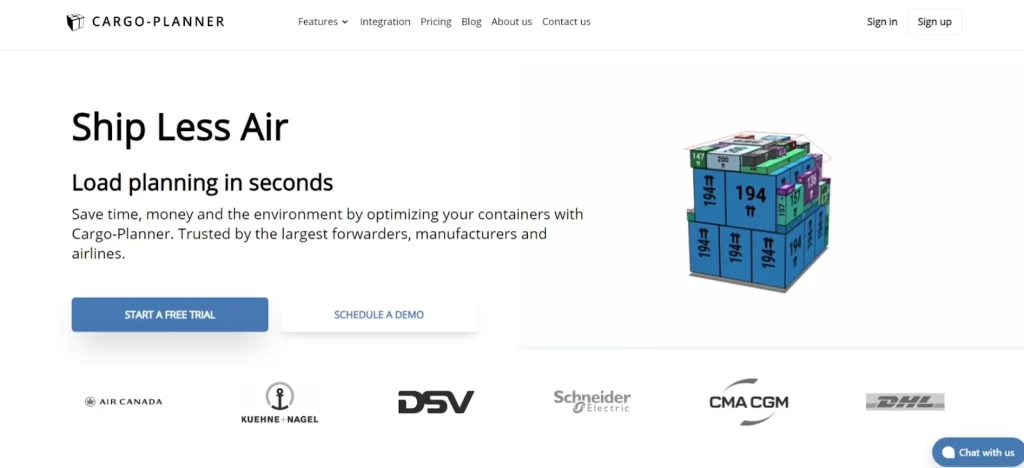
The Cargo-planner enable their customers to create their own custom containers with measurements, wall configurations, and other important shipping aspects. Businesses can use their SDK and APIs to access an entire 3D viewing of the container and its loads. The platforms allow cargo oversizing in different varieties, such as open tops, flat racks, flatbed trailers, etc.
- Founded in: 2015
- Developed by: Tornblom Software
- Headquarters: Sweden
- Starting price: $59 per month
5. Trucking Office
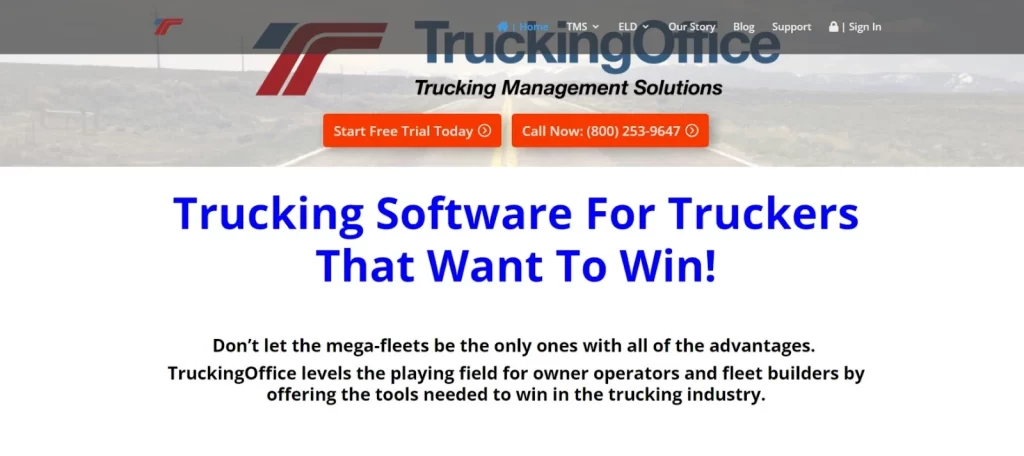
An online tracking management platform that supports mid-size and small trucking businesses with up to ten trucks. The tracking office provides varieties of features to its customers, such as load planning, dispatch management, driver settlement, expense monitoring, tax filing, and reporting.
Moreover, the platform supports multiple driver payment models, such as manual pay entry, pay-per-mile pay by percentage, and fixed monthly pay. Additionally, the platform supports easy organization of the fleet by supporting an easy and seamless trucking business operation.
- Founded in: 2005
- Developed by: Trucking Office
- Headquarters: US
- Starting price: $20 per month
Tech stack For Developing Load Planning Software
Selecting the right technical stack is crucial for ensuring the performance, scalability, and maintainability of your load planning software in the long run. Here is the list of recommended technical stacks you can consider for your project.
1. Programming Languages
- Python
- JavaScript
2. Backend Framework
- Django
- Node.js
3. Database
- PostgreSQL
- MongoDB
4. Frontend Framework
- React
- Angular
- Vue.js
5. Visualization Libraries
- D3.js
- Three.js
6. Algorithm Libraries
- SciPy
- NumPy
7. Cloud Services
Amazon Web Services (AWS) or Microsoft Azure
8. Version Control
Git: Use Git for version control to track changes, collaborate with a team, and manage code efficiently.
9. DevOps Tools
- Docker
- (CI/CD) Continuous Integration and Continuous Deployment tools
It is essential to note that the selection of the technical stack depends on the team, expertise, scalability & project requirements.
During tech stack selection, always aim to keep the balance between development speed, performance, and maintainability for your load planning app development.
Conclusion
A well-developed and efficiently implemented load planning application can help the transportation industry to enhance logistics and operations by optimizing cargo arrangement. Also, businesses can minimize transportation costs and ensure safety and compliance with regulations. The tools provided with load planning software enable businesses and companies to make informed decisions about their load scheduling.
However, developing load planning software involves carefully considering different aspects of software development, such as defining project scope, market research, programming, API, integration, etc. Therefore, working with an app development company is the best decision, as the company can help you identify your business needs by delivering an optimized solution for your logistics business with software development.
Idea Usher offers transportation software development services that can help you scale your business operations and optimize inventory processes, in addition to reducing your operational costs.
Contact us today to learn more about how we can help you establish and scale your logistics and transportation business.
Contact Idea Usher
Work with Ex-MAANG developers to build next-gen apps schedule your consultation now
Email:
Phone:
(+1)732 962 4560
(+91)859 140 7140
FAQ
Q. What is load planning software?
A. A software designed to organize parcels and other cargo goods inside moving trucks, trailers, containers, and other types of vehicles. The main goal of load planning software is to effectively use the space that is available in vehicles while also making sure that the weight distribution is balanced and the cargo is securely fastened.
Q. What are the components of load planning?
A. Collaboration, cost optimization, and consolidation are the three essential components of load planning.
Q. How to develop load planning software?
A. The following steps will help you develop a load planning application: establish a strategy for your logistics business, set up load optimization algorithms, select your software development partner, start UI/UX design and architecture, develop MVP of load planning software, test & deploy your software.




















